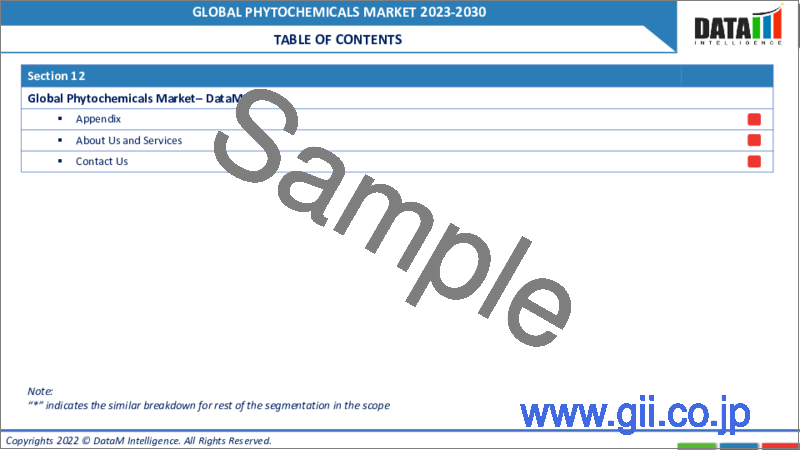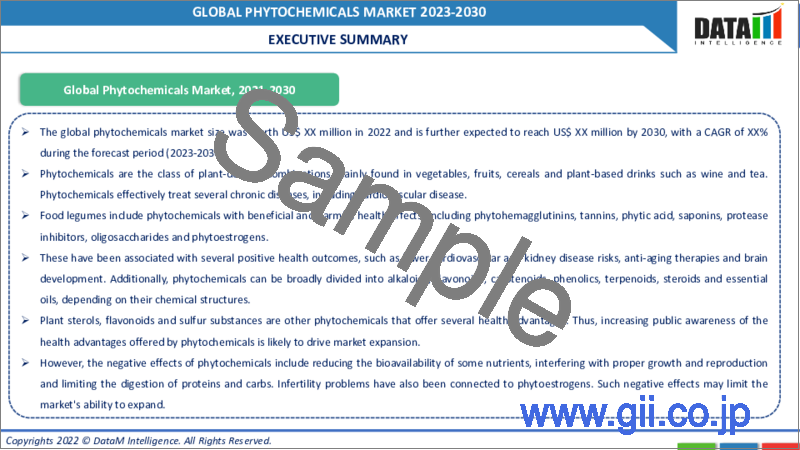|
|
市場調査レポート
商品コード
1208668
ファイトケミカルの世界市場-2022-2029Global Phytochemicals Market - 2022-2029 |
||||||
|
● お客様のご希望に応じて、既存データの加工や未掲載情報(例:国別セグメント)の追加などの対応が可能です。 詳細はお問い合わせください。 |
|||||||
| ファイトケミカルの世界市場-2022-2029 |
|
出版日: 2023年02月01日
発行: DataM Intelligence
ページ情報: 英文 209 Pages
納期: 約2営業日
|
- 全表示
- 概要
- 目次
市場の概要
ファイトケミカルの世界市場規模は、予測期間(2022-2029年)にCAGR8.9%で成長すると予測されています。
ファイトケミカルとして知られる植物由来の化合物は、野菜、果物、穀物、およびワインやお茶などの植物性飲料を含む食品を構成しています。心血管系疾患は、ファイトケミカルが治療に成功したいくつかの慢性疾患の1つです。豆類には、フィトヘマグルチニン、タンニン、フィチン酸、サポニン、プロテアーゼ阻害剤、オリゴ糖、フィトエストロゲンなど、健康にプラスにもマイナスにも作用する様々なファイトケミカルが含まれています。
これらは、腎臓や心血管疾患のリスク低下、アンチエイジング治療、脳の成長など、いくつかの有益な健康効果に関連しています。植物化学物質は、その化学構造により、アルカロイド、フラボノイド、カロテノイド、フェノール、テルペノイド、ステロイド、エッセンシャルオイルに一般的に分類されます。
市場力学
世界の植物化学品市場は、消費者の健康意識の高まりと、動物飼料における植物化学品の使用の増加によって牽引されると予測されています。しかし、ファイトケミカルの副作用が予測期間中の市場成長を制限する可能性があります。
植物化学物質によって提供される健康上の利点に関する人々の意識の高まり
人々は、オーガニックライフスタイルへの移行が進むにつれて、ファイトケミカルをより頻繁に使用するようになっています。有名な医療研究機関であるロズウェル・グループは、植物化学物質を摂取することで心臓病やがんの発症リスクを軽減できると主張しています。米国がん研究所は、がん患者にはファイトケミカルを摂取することが有益であると助言しています。
これらの特典に加え、ラガーストロエア・スペシオサやラガーストロエア・フロリバンダといった植物からのファイトケミカル抽出物は、肌に関するネガティブな副作用がないため、スキンケア処方の中で幅広いアンチエイジング効果が期待されているのです。消費者のライフスタイルの変化や外見へのこだわりの増加により、フィトケミカルの需要は増加すると予測されています。
動物飼料におけるフィトケミカルの用途の増加
調査によると、オーガニックライフスタイルへの移行が進むにつれ、人々はより頻繁に植物化学物質を使用するようになりました。有名な医療研究機関であるロズウェル・グループは、ファイトケミカルを摂取することで心臓病やがんの発症リスクを軽減できると主張しています。
ファイトケミカルのような代替成長促進剤も開発されました。数十年前に使用が提案されたもの、パフォーマンスにどのような影響を与えるかについては、かなりの論争がありました。ファイトケミカルの生物学的特性、例えば免疫の発達への影響、抗菌性、抗酸化性、抗ストレス性、ニュートリゲノミック特性は、畜産における成長促進剤としての魅力を高めています。
ファイトケミカルの副作用
ファイトケミカルは、人が広く食している多くの植物に含まれる化合物で、一般的には、自然に生成されるため、食べても安全だと考えられています。しかし、必ずしもそうとは限りません。実際、一般的に摂取されている多くの植物に含まれるいくつかの天然由来の化合物には、発がん性や腫瘍の成長を促進する作用があり、避けるべきとされています。
NCBIによると、植物における植物化学物質の蓄積は、栄養不足、病原菌の攻撃、植物種の競合同居、虫の捕食、草食動物の攻撃などの環境要因や生育条件に影響されます。例えば、植物や作物の生化学的プロセスは、植物化学物質の蓄積を制限または変更するような農法によって影響を受ける可能性があります。
COVID-19の影響分析
数多くの種類の研究が、COVID-19流行の副作用を軽減するために有機化合物を採用することに焦点を当てています。そのような努力の中には、コロナウイルス耐性(特にSARS-CoV-2)に対する植物化学物質のin vivoおよびin vitroテストがあります。ウイルス性疾患とその影響を含む様々な病気の治療に薬用植物と単離されたファイトケミカルを採用する利点は、多くの治療標的を同時に扱うことができることです。
COVIDファミリーウイルス、特にSARS-CoV-2に感染すると、肺系にひどい影響を与えるため、植物の二次代謝産物はこれらの肺の問題を大きく軽減することができます。他の分子標的やシグナル伝達系の中でも、炎症促進や酸化メディエーターは、植物化学物質によって減少させることができます。
目次
第1章 ファイトケミカルの世界市場の調査手法と範囲
- 調査手法
- 調査目的および調査範囲
第2章 ファイトケミカルの世界市場-市場の定義と概要
第3章 ファイトケミカルの世界市場- エグゼクティブサマリー
- タイプ別市場内訳
- エンドユーザー別市場内訳
- 地域別市場内訳
第4章 ファイトケミカルの世界市場-市場力学
- 市場影響因子
- 促進要因
- ファイトケミカルがもたらす健康効果に関する人々の意識の高まり
- 動物飼料におけるファイトケミカルの用途の増加
- 抑制要因
- ファイトケミカルの副作用
- 機会
- 影響分析
- 促進要因
第5章 世界のファイトケミカル市場-産業分析
- ポーターのファイブフォース分析
- サプライチェーン分析
- 価格設定分析
- 規制分析
第6章 ファイトケミカルの世界市場-COVID-19分析
- COVID-19の市場分析
- COVID-19市場参入前のシナリオ
- COVID-19の現在の市場シナリオ
- COVID-19の後、または将来のシナリオ
- COVID-19の中での価格ダイナミクス
- 需要-供給スペクトラム
- パンデミック時の市場に関連する政府の取り組み
- メーカーの戦略的な取り組み
- まとめ
第7章 ファイトケミカルの世界市場- タイプ別
- カロテノイド
- フラボノイド
- フィトステロールズ
- アルカロイド
- テルペノイド
- ステロイド類
- 精油
- その他
第8章 ファイトケミカルの世界市場- エンドユーザー別
- 医薬品
- 機能性飲料
- 機能性食品
- 栄養補助食品
- パーソナルケア、化粧品
- 動物栄養学
- その他
第9章 ファイトケミカルの世界市場- 地域別
- 北米
- 米国
- カナダ
- メキシコ
- 欧州
- ドイツ
- 英国
- フランス
- イタリア
- スペイン
- その他欧州
- 南米
- ブラジル
- アルゼンチン
- その他の南米地域
- アジア太平洋地域
- 中国
- インド
- 日本
- オーストラリア
- その他アジア太平洋地域
- 中東とアフリカ
第10章 ファイトケミカルの世界市場- 競争情勢
- 競合シナリオ
- 市況/シェア分析
- M&A(合併・買収)分析
第11章 ファイトケミカルの世界市場-企業プロファイル
- Cargill, Incorporated
- 企業概要
- 製品ポートフォリオと説明
- 主なハイライト
- 財務概要
- BASF SE
- Arboris, LLC
- Givaudan
- Indena S.p.A.
- DUPONT DE NEMOURS INC.
- LINNEA SA
- MARTIN BAUER
- LIPOFOODS
- AEB Group
第12章 ファイトケミカルの世界市場- 重要考察
第13章 ファイトケミカルの世界市場-DataM
Market Overview
The global phytochemicals market size was worth US$ XX million in 2021 and is estimated to reach US$ XX million by 2029, growing at a CAGR of 8.9% during the forecast period (2022-2029).
The plant-derived compounds known as phytochemicals comprise foods including vegetables, fruits, cereals and plant-based beverages like wine and tea. Cardiovascular illness is one of several chronic diseases that phytochemicals successfully treat. Food legumes include a variety of phytochemicals, including phytohemagglutinins, tannins, phytic acid, saponins, protease inhibitors, oligosaccharides and phytoestrogens, which can have both positive and negative impacts on health.
These have been linked to several beneficial health effects, including decreased kidney and cardiovascular disease risk, anti-aging treatments and brain growth. According to their chemical structures, phytochemicals can also be generically classified as alkaloids, flavonoids, carotenoids, phenolics, terpenoids, steroids and essential oils.
Market Dynamics
The worldwide phytochemicals market is predicted to be driven by increased health awareness among consumers and increasing use of phytochemicals in animal feed. However, phytochemical side effects may limit market growth during the predicted period.
Rising awareness in people regarding the health benefits provided by phytochemicals
People are using phytochemicals more frequently as they transition more and more toward an organic lifestyle. The Roswell Group, a renowned medical research organization, asserts that consuming phytochemicals reduces the risk of developing heart disease and cancer. The American Institute of Cancer Research advises that cancer patients may benefit from ingesting phytochemicals.
In addition to these benefits, phytochemical extracts from plants like Lagerstroemia speciosa and Lagerstroemia floribunda, which don't have any negative skin-related side effects, have a wide range of anti-aging properties in skincare formulae. Due to consumer lifestyle changes and an increased focus on appearance, the demand for phytochemicals is predicted to rise.
Rising application of phytochemicals in animal feed
According to research, people use phytochemicals more frequently as they transition more and more toward an organic lifestyle. The Roswell Group, a renowned medical research organization, asserts that consuming phytochemicals reduces the risk of developing heart disease and cancer.
Alternative growth stimulants, such as phytochemicals, have developed. Although it was first proposed that they be used a few decades ago, there has been considerable controversy regarding how they impact performance. The biological properties of phytochemicals, such as their effects on the development of immunity and their antibacterial, antioxidant, anti-stress and nutrigenomic properties, have made them attractive for use as growth promoters in animal husbandry.
Side effects of phytochemicals
Phytochemicals are compounds found in many plants that are extensively consumed by people and are typically thought to be safe to eat because they are produced naturally. It isn't always the case, though; in fact, several naturally occurring compounds found in many commonly ingested plants have the capacity to either cause cancer or encourage the growth of tumors and should be avoided.
The accumulation of phytochemicals in plants is influenced by environmental factors or growth conditions such as nutritional deprivation, pathogen assault, competitive cohabitation of plant species, insect predation and herbivore attack, according to NCBI. For instance, the biochemical processes in plants or crops may be impacted by agricultural practices, which may limit or alter the accumulation of phytochemicals.
COVID-19 Impact Analysis
Numerous types of research have focused on employing organic compounds to alleviate the COVID-19 epidemic's side effects. Among such efforts is the in vivo and in vitro testing of phytochemicals for coronavirus resistance (especially SARS-CoV-2). The advantages of employing medicinal plants and isolated phytochemicals for treating various illnesses, including viral diseases and their effects, include their capacity to address many therapeutic targets simultaneously.
Secondary plant metabolites can greatly minimize these pulmonary issues because infection with any COVID family virus, particularly SARS-CoV-2, can badly affect the pulmonary system. Pro-inflammatory and oxidant mediators, among other molecular targets and signaling systems, can be reduced by phytochemicals.
Segment Analysis
By end-user, the phytochemicals market is segmented into pharmaceuticals, functional beverages, functional food, dietary supplements, personal care & cosmetics, animal nutrition and others.
Wide usage of phytochemicals in pharmaceuticals
Due to expanded studies in the area, scientists have found numerous uses for phytochemicals in the pharmaceutical business. Phytochemicals reduce the risk of developing cancer and numerous other chronic diseases, such as diabetes, heart disease, stroke, Alzheimer's and Parkinson's. The pharmaceutical sector is interested in seeing its use increase in developing various treatments for these illnesses.
Because the goods were obtained and produced ethically and organically, BASF SE approved five active ingredients through the COSMOS criteria in 2020. It is the largest manufacturer and distributor of natural cosmetics containing active ingredients. 145 of the cosmetic compounds produced by BASF SE are COSMO-registered globally. Flavonoids are widely used in the pharmaceutical sector. Flavonoid, an enzyme that raises immunity and lowers the risk of cancer, cardiovascular disease and other disorders, is mostly to blame. As a result, the pharmaceutical sector now needs more flavonoids.
Geographical Analysis
Strong pharmaceutical sector in North America
The market for phytochemicals is anticipated to be dominated by North America. According to cbo.gov, the pharmaceutical industry spent US$ 83 billion on R&D expenses in 2019 and numerous new pharmaceuticals have been developed in U.S. in recent years that offer significant medical benefits. Phytochemicals are employed in the pharmaceutical sector to create drugs because they have the bioactive potential to combat lung cancer and cardiovascular illnesses. Additionally, phytochemicals have metabolites; therefore, the emphasis is now on exploiting natural resources for medicine delivery rather than chemicals.
Thirty-eight new medications were approved by the Food and Drug Administration (FDA) between 2010 and 2019, a 60% increase annually. Pharmaceutical investment in 2019 was estimated to be over US$ 83 billion, with large and small drug manufacturing companies generally focusing on various R&D efforts. By avoiding infections, treating stomach ulcers and having an anti-microbial effect, these features increase the usage of phytochemicals. According to Volza, Canada will be one of the countries importing the most medicines in 2020, accounting for 7,514 shipments. Phytochemicals are gaining popularity due to their low toxicity as medicinal alternatives.
Competitive Landscape
The major market players are utilizing strategies like alliances and acquisitions, product launches and partnerships to broaden the appeal of their products, develop their product portfolios and increase their competitiveness in the worldwide phytochemicals market.
Major global phytochemicals market companies include Cargill, Incorporated, BASF SE, Arboris, LLC, Givaudan, Indena S.p.A., DUPONT DE NEMOURS INC., LINNEA SA, MARTIN BAUER, LIPOFOODS and AEB Group.
Cargill, Incorporated
Overview: An American-based, privately held multinational food corporation is Cargill, Incorporated. In Europe, Americas, Asia-Pacific, Middle East and Africa, the corporation has operations in 70 different nations. Around 125 nations around the world are where the company offers its products. They continue to develop goods that meet consumer needs while advancing nutrition, food safety and sustainability.
The company portfolio concentrates its creative efforts on developing more ecologically responsible methods of supplying customers, consumers and society with the commodities they need. They aid in the delivery of carbon-neutral iron ore.
Product Portfolio: Plant Sterols and CoroWise Plant Sterols are offered for sale by the company. Cargill manufactures and markets a series of plant sterols under the trade name CoroWise. Plant sterols are advised by the National Cholesterol Education Program, Lung and Blood Institute of the National Institutes of Health. Many vegetable oils, seeds, nuts and grains contain plant sterols. Plant sterols are backed by an FDA health claim and recommended by the National Cholesterol Education Program (NCEP) of the National Institutes of Health. Foods, beverages and supplements all contain Cargill's CoroWise plant sterols.
Key Development: Cargill said it would purchase Delacon, a producer of phytogenic chemicals derived from plants, in 2022. Increased manufacturing of nutrient-dense foods, a global footprint and in-depth knowledge of feed additives will all arise from the acquisition.
Why Purchase the Report?
- Visualize the composition of the phytochemicals market segmentation by type, end-user and region, highlighting the critical commercial assets and players.
- Identify commercial opportunities in the phytochemicals market by analyzing trends and co-development deals.
- Excel data sheet with thousands of phytochemicals market-level 4/5 segmentation points.
- Pdf report with the most relevant analysis cogently put together after exhaustive qualitative interviews and in-depth market study.
- Product mapping in excel for the key product of all major market players
The global phytochemicals market report would provide access to an approx. 53 market data table, 51 figures and 209 pages.
Target Audience 2022
- Phytochemicals Service Providers/ Buyers
- Industry Investors/Investment Bankers
- Education & Research Institutes
- Emerging Companies
- Phytochemicals Manufacturers
Table of Contents
1. Global Phytochemicals Market Methodology and Scope
- 1.1. Research Methodology
- 1.2. Research Objective and Scope of the Report
2. Global Phytochemicals Market - Market Definition and Overview
3. Global Phytochemicals Market - Executive Summary
- 3.1. Market Snippet By Type
- 3.2. Market Snippet By End-User
- 3.3. Market Snippet By Region
4. Global Phytochemicals Market-Market Dynamics
- 4.1. Market Impacting Factors
- 4.1.1. Drivers
- 4.1.1.1. Rising awareness in people regarding the health benefits provided by phytochemicals
- 4.1.1.2. Rising application of phytochemicals in animal feed
- 4.1.2. Restraints
- 4.1.2.1. Side effects of phytochemicals
- 4.1.2.2. XX
- 4.1.3. Opportunity
- 4.1.3.1. XX
- 4.1.4. Impact Analysis
- 4.1.1. Drivers
5. Global Phytochemicals Market - Industry Analysis
- 5.1. Porter's Five Forces Analysis
- 5.2. Supply Chain Analysis
- 5.3. Pricing Analysis
- 5.4. Regulatory Analysis
6. Global Phytochemicals Market - COVID-19 Analysis
- 6.1. Analysis of COVID-19 on the Market
- 6.1.1. Before COVID-19 Market Scenario
- 6.1.2. Present COVID-19 Market Scenario
- 6.1.3. After COVID-19 or Future Scenario
- 6.2. Pricing Dynamics Amid COVID-19
- 6.3. Demand-Supply Spectrum
- 6.4. Government Initiatives Related to the Market During Pandemic
- 6.5. Manufacturers Strategic Initiatives
- 6.6. Conclusion
7. Global Phytochemicals Market - By Type
- 7.1. Introduction
- 7.1.1. Market Size Analysis and Y-o-Y Growth Analysis (%), By Type
- 7.1.2. Market Attractiveness Index, By Type
- 7.2. Carotenoids*
- 7.2.1. Introduction
- 7.2.2. Market Size Analysis and Y-o-Y Growth Analysis (%)
- 7.3. Flavonoids
- 7.4. Phytosterols
- 7.5. Alkaloids
- 7.6. Terpenoids
- 7.7. Steroids
- 7.8. Essential Oils
- 7.9. Others
8. Global Phytochemicals Market - By End-User
- 8.1. Introduction
- 8.1.1. Market Size Analysis and Y-o-Y Growth Analysis (%), By End-User
- 8.1.2. Market Attractiveness Index, By End-User
- 8.2. Pharmaceuticals*
- 8.2.1. Introduction
- 8.2.2. Market Size Analysis and Y-o-Y Growth Analysis (%)
- 8.3. Functional Beverages
- 8.4. Functional food
- 8.5. Dietary Supplements
- 8.6. Personal Care & Cosmetics
- 8.7. Animal Nutrition
- 8.8. Others
9. Global Phytochemicals Market - By Region
- 9.1. Introduction
- 9.2. Market Size Analysis and Y-o-Y Growth Analysis (%), By Region
- 9.3. Market Attractiveness Index, By Region
- 9.4. North America
- 9.4.1. Introduction
- 9.4.2. Key Region-Specific Dynamics
- 9.4.3. Market Size Analysis and Y-o-Y Growth Analysis (%), By Type
- 9.4.4. Market Size Analysis and Y-o-Y Growth Analysis (%), By End-User
- 9.4.5. Market Size Analysis and Y-o-Y Growth Analysis (%), By Country
- 9.4.5.1. U.S.
- 9.4.5.2. Canada
- 9.4.5.3. Mexico
- 9.5. Europe
- 9.5.1. Introduction
- 9.5.2. Key Region-Specific Dynamics
- 9.5.3. Market Size Analysis and Y-o-Y Growth Analysis (%), By Type
- 9.5.4. Market Size Analysis and Y-o-Y Growth Analysis (%), By End-User
- 9.5.5. Market Size Analysis and Y-o-Y Growth Analysis (%), By Country
- 9.5.5.1. Germany
- 9.5.5.2. UK
- 9.5.5.3. France
- 9.5.5.4. Italy
- 9.5.5.5. Spain
- 9.5.5.6. Rest of Europe
- 9.6. South America
- 9.6.1. Introduction
- 9.6.2. Key Region-Specific Dynamics
- 9.6.3. Market Size Analysis and Y-o-Y Growth Analysis (%), By Type
- 9.6.4. Market Size Analysis and Y-o-Y Growth Analysis (%), By End-User
- 9.6.5. Market Size Analysis and Y-o-Y Growth Analysis (%), By Country
- 9.6.5.1. Brazil
- 9.6.5.2. Argentina
- 9.6.5.3. Rest of South America
- 9.7. Asia-Pacific
- 9.7.1. Introduction
- 9.7.2. Key Region-Specific Dynamics
- 9.7.3. Market Size Analysis and Y-o-Y Growth Analysis (%), By Type
- 9.7.4. Market Size Analysis and Y-o-Y Growth Analysis (%), By End-User
- 9.7.5. Market Size Analysis and Y-o-Y Growth Analysis (%), By Country
- 9.7.5.1. China
- 9.7.5.2. India
- 9.7.5.3. Japan
- 9.7.5.4. Australia
- 9.7.5.5. Rest of Asia-Pacific
- 9.8. Middle East and Africa
- 9.8.1. Introduction
- 9.8.2. Key Region-Specific Dynamics
- 9.8.3. Market Size Analysis and Y-o-Y Growth Analysis (%), By Type
- 9.8.4. Market Size Analysis and Y-o-Y Growth Analysis (%), By End-User
10. Global Phytochemicals Market - Competitive Landscape
- 10.1. Competitive Scenario
- 10.2. Market Positioning/Share Analysis
- 10.3. Mergers and Acquisitions Analysis
11. Global Phytochemicals Market - Company Profiles
- 11.1. Cargill, Incorporated
- 11.1.1. Company Overview
- 11.1.2. Product Portfolio and Description
- 11.1.3. Key Highlights
- 11.1.4. Financial Overview
- 11.2. BASF SE
- 11.3. Arboris, LLC
- 11.4. Givaudan
- 11.5. Indena S.p.A.
- 11.6. DUPONT DE NEMOURS INC.
- 11.7. LINNEA SA
- 11.8. MARTIN BAUER
- 11.9. LIPOFOODS
- 11.10. AEB Group
LIST NOT EXHAUSTIVE
12. Global Phytochemicals Market - Premium Insights
13. Global Phytochemicals Market - DataM
- 13.1. Appendix
- 13.2. About Us and Services
- 13.3. Contact Us




